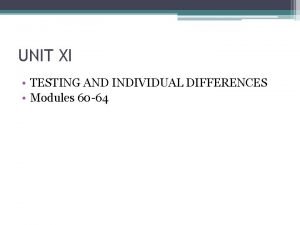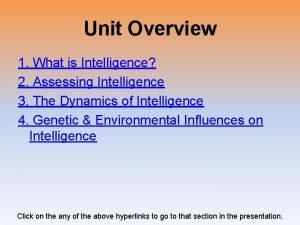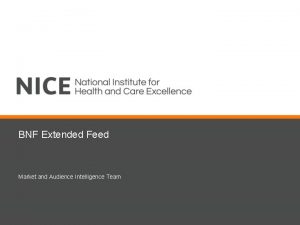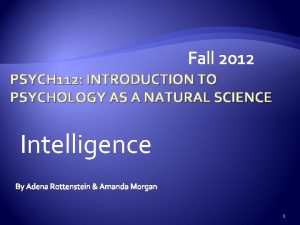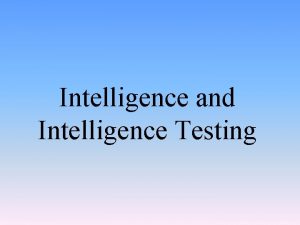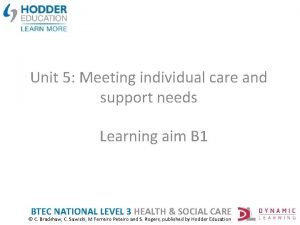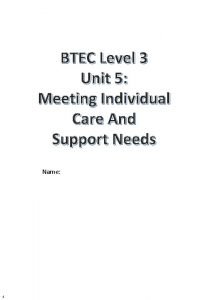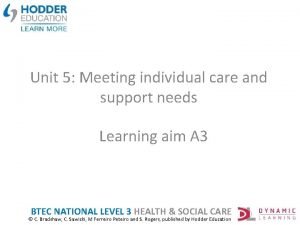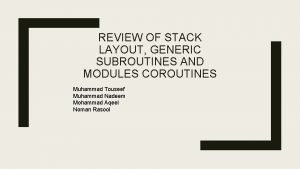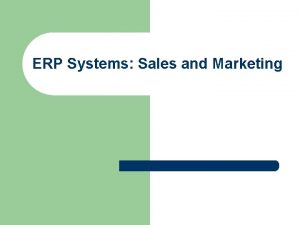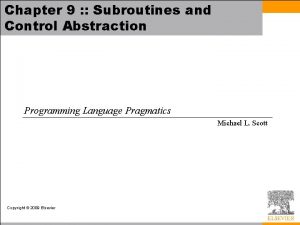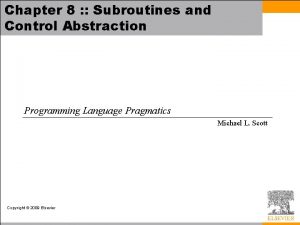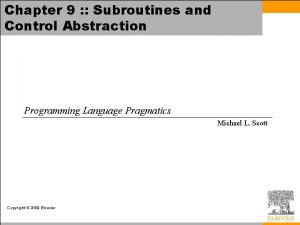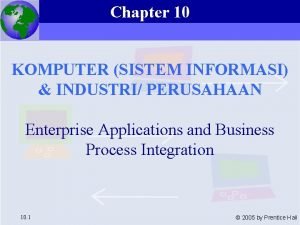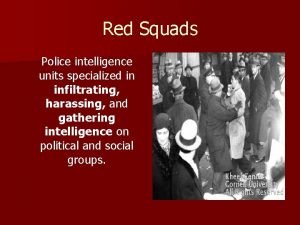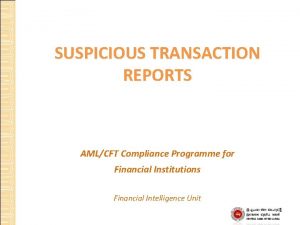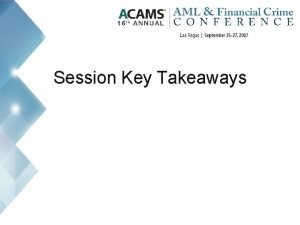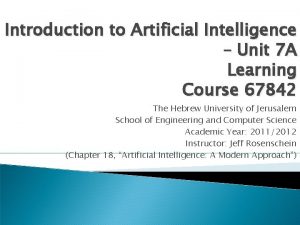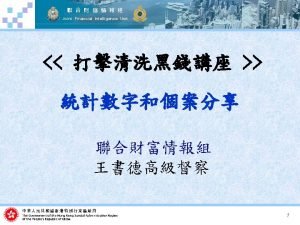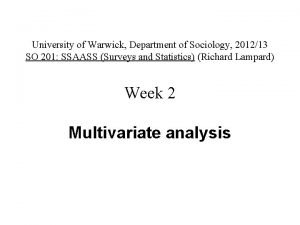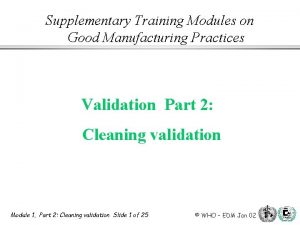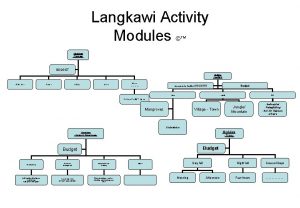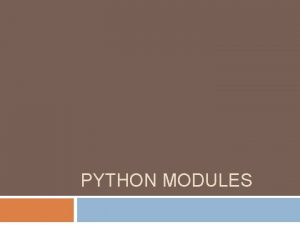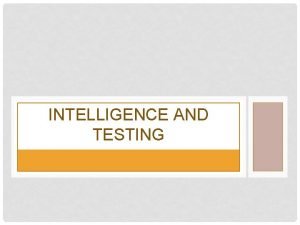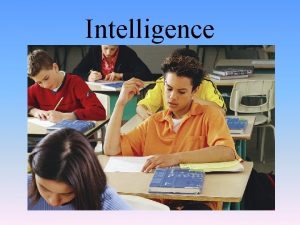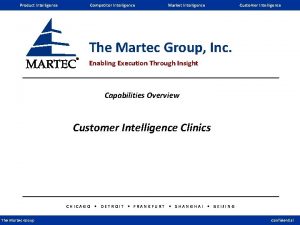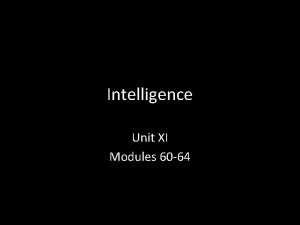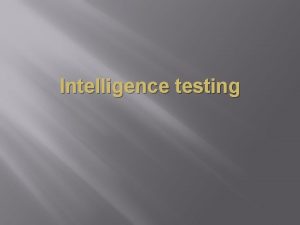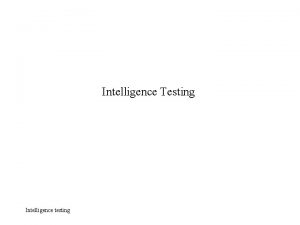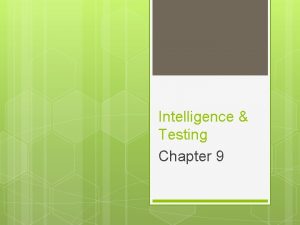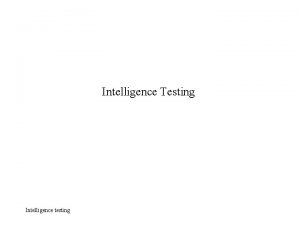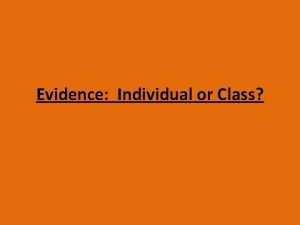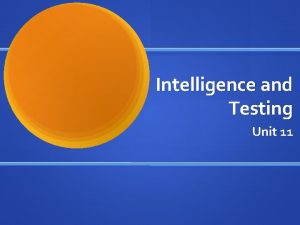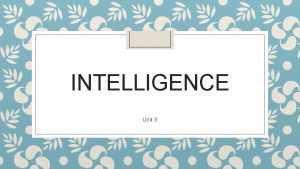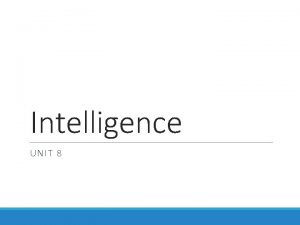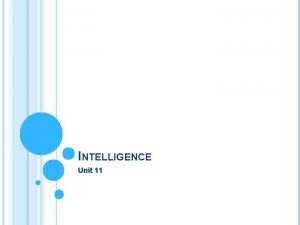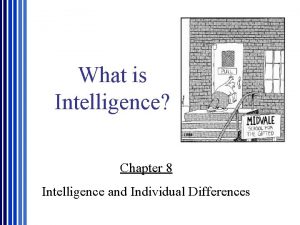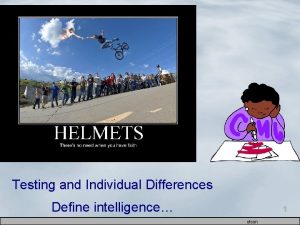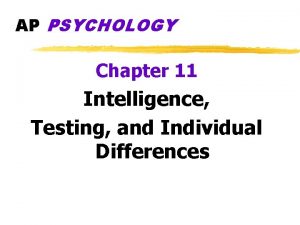Unit 11 Intelligence and Individual Testing MODULES 60











































- Slides: 43

Unit 11 - Intelligence and Individual Testing MODULES 60 -64

Unit 11 Overview. o. Intelligence defined. o What is it? o. Intelligence, testing, and IQ. o Binet, Terman, Stern, Wechsler o. Culture and intelligence. o How does culture affect our definition of intelligence? o. Theories of intelligence.

How is Intelligence Defined? o. Definition- the ability to acquire and apply knowledge and skills. o. Abstract vs verbal intelligence. o. Speed of processing. o. Intelligence is having a capacity to act purposefully ◦ To think rationally ◦ To deal effectively with the environment ◦ Learn from experience ◦ Solving problems ◦ Use knowledge to deal with new situations or events.

Fluid vs. Crystallized Intelligence o. Raymond Cattell 1905 -98 o. Fluid intelligence is defined as the ability to solve new problems, use logic in new situations, and identify patterns. o. Crystallized intelligence is defined as the ability to use learned knowledge and experience.

Emotional Intelligence o. Emotional intelligence is the ability to: o perceive, o understand, o manage, o and use your emotions. o. People with high emotional intelligence are both socially and self-aware. o. Have higher quality interactions with friends. o. Unconscious process.

Aptitude and Achievement o. Aptitude predicts a capacity for learning certain abilities o. People with high aptitude- will do well o. Aptitude tests- measure narrow range of abilities o SAT = Scholastic Assessment Test o Measures aptitude for language, math, reasoning o. Achievement tests o Class tests, quizzes, drivers test, midterms and finals.

Intelligence and Testing o. Alfred Binet – 1904 o. The first to develop modern intelligence testing o. Intelligence is not fixed, but can change o. Theorized mental aptitude is a general capacity that can be expressed in different ways. o. Did not attempt to make assumptions about why a student scored how they did.

Galton and Eugenics o. Eugenics means well born o. Francis Galton 1822 -1911 o focused on positive eugenics o. Encourage healthy people of above average intelligence to have children o. Creation of “improved” human race o. Negative Eugenics took hold in US and Germany o. Poor working class reproduced more, creating fear of Anglo-saxon heritage being lost.

Intelligence and Testing, cont. o. Lewis Terman o. Developed the Stanford-Binet intelligence test o. Test extended from teenagers to “superior adults”. o. Test results shows intelligence someone was born with. o. William Stern o. Developed IQ test based off of Stanford-Binet test.

Intelligence Quotients (IQ) o. To accurately measure intelligence, we need to know: ◦ Chronological age (CA) ◦ Mental age (MA)= (average intellectual performance)= level of age-ranked questions she or he can answer ◦ IQ = from dividing one number into another. ◦ MA/CA X 100 = IQ

Calculating IQ o. When mental age and chronological age is the same or similar = normal intelligence 100 or near… o. Average ranges= 90 -109 intelligence o. When the mental age is higher than the chronological age- intelligence is higher

Longitudinal vs cross-sectional Longitudinal study (long term) Terman. Termites studied over long period of time. 35 years. Cross sectional- A point in time, studies part of a group.

Intelligence and Testing, cont. o. David Wechsler o. Developed the Wechsler Adult Intelligence Scale (WAIS) and Wechsler Intelligence Scale for Children (WISC). o. Currently the most used individual intelligence test. o. Provides an overall score, as well as separate scores for: o. Verbal comprehension o. Perceptual organization o. Working memory o. Processing speed

WAIS Subtests

Quantitative Reasoningo. Measure a person’s ability to solve problems involving numbers. o. Questions emphasize practical problems vs mathematical knowledge o. Given the number 3, 6, 9, 12 what number would come next?

Visual-Spatial Processing o. Assesses someone’s ability to see patterns and relationships in visual displays ◦ Examples- putting picture puzzles together ◦ Working with geometric shapes ◦ Reproducing patterns of blocks

The normal curve Bell Curve. Number of scores Ninety-five percent of all people fall within 30 points of 100 55 70 Sixty-eight percent of people score within 15 points above or below 100 85 100 115 130 Wechsler intelligence score 145

Bias and testing o. Bias is associated with IQ and jobs that require academic degrees o. Test measure a particular type of intelligence (Fluid Reasoning, Knowledge, Quantitative Reasoning, Visual-Spatial Processing, Working Memory) o. Studies show that African Americans score lower on IQ scores because of cultural bias. o. Women perform better at verbal fluency, spelling, locating objects, detecting emotions and are more sensitive to touch, taste, and colors o. Men perform better at spatial ability, complex math problems. o Males scores vary more then women. Appear at the extremes of the curve

Intelligence testing labels o. For scores that fall at one extreme of the normal curve o Top or bottom 2% o. Intellectual disability o Unusually low test scores below 70 IQ o Can be challenged to meet normal demands of living independently. o Limited ability in o Conceptual skills o Social skills o Practical skills o. Example-Down Syndrome- caused by extra chromosome 21 o alters the course of development o The average IQ of a young adult with Down syndrome is 50, equivalent to the mental ability of an 8 - or 9 -year-old child, but this can vary widely. o Some children with Down syndrome are educated in typical school classes, while others require more specialized education.

Intelligence labels: Intellectual Disability o. PKU- Phenylketonuria-inherited disorder that causes an amino acid called phenylalanine to build up in the body. o. PKU is caused by a defect in the gene that helps create the enzyme needed to break down phenylalanine. Neurological problems that may include seizures Abnormally small head (microcephaly) Hyperactivity Intellectual disability Delayed development Behavioral, emotional and social problems Psychiatric disorders

Fragile X o. Fragile X syndrome is a genetic condition that causes ◦ learning disabilities ◦ cognitive impairment. o. Usually, males are more severely affected by this disorder than females. o. Affected individuals usually have delayed development of speech and language by age 2. o. Most males with Fragile X syndrome have mild to moderate intellectual disability, while about one-third of affected females are intellectually disabled

Hydrocephaly o. The term hydrocephalus is derived from the Greek words "hydro" meaning water and "cephalus" meaning head ocan arise before birth or any time afterward. o. Cerebrospinal fluid (CSF) is a clear, colorless body fluid found in the brain and spinal cord. CSF is made continuously. o. Medical conditions that block its normal flow or absorption will result in an over-accumulation of CSF. The resulting pressure of the fluid against brain tissue is what causes hydrocephalus o. It may be due to many causes including a birth defect, hemorrhage into the brain, infection, meningitis, tumor, or head injury. o. Uncomplicated (genetic) hydrocephalus has a better cognitive prognosis than hydrocephalus associated with brain injury. In recent studies two-thirds of children with hydrocephalus had normal or borderline normal intelligence

Microcephaly https: //www. cdc. gov/ncbddd/birthdefects/microcephaly. html o. Baby’s head is smaller then it should be. o. Brain stops developing while in the womb or after birth o. Suffer from seizures o. Developmental delay, such as problems with speech or other developmental milestones o. Intellectual disability (decreased ability to learn and function in daily life) o. Problems with movement, balance, and feeding o. Hearing loss and vision problems

Cretinism (Congenital hypothyroidism) oinadequate thyroid hormone production in newborn infants. o It can occur because of oan anatomic defect in the gland, oan inborn error of thyroid metabolism, or oiodine deficiency. o. Newborns with borderline thyroid function at higher risk of poor neurodevelopmental outcomes o. Causes a developmental delay.

Intelligence testing labels, cont. o. Giftedness ◦ Terman found that gifted students are: ◦ Healthy. ◦ Well adjusted. Emotional intelligence ◦ Unusually academically successful. ◦ Hold careers that require high levels of education. ◦ Piaget was publishing scientific works at age 15.

Intelligence testing labels, cont. o. Savant o. Score low on intelligence tests o. Sometimes unable to perform regular tasks, such as, o. Dressing o. Poor social skills o. Are highly proficient in one particular skill or ability. o. Example: music, calculation, memorization. o. Helps Garner develop his theory of multiple intelligences.

Super Cool IQ facts: o. Modern IQ scores are associated with “Deviation Scores= o. Based on a person’s relative standing in his or her age group. ” o. Tell how far above or below average a person’s scores fall. o. IQ doesn’t really change after age 16, oalcoholism or drug use causes a decline in IQ

Test Construction: Standardization. o. Standardization o. A basis of comparison is needed for any score to be meaningful. o. The test is given to a group that represents the target audience for that test. o. Scores can be compared to create a scoring STANDARD. o. All tests given must use the same procedures to be considered standardized.

Test Construction: Reliability o. Tests must be reliable for the scores to have meaning and be useful. o A reliable test provides consistent scores. o. Retests can be used to check reliability. o. Test-retest o. Split half scores o. Stanford-Binet, WAIS, and WISC are all considered highly reliable.

Test Construction: Validity o. Test Validity o. How well a test measures what its supposed to test. o. Content validity- A test contains content and questions that was covered within the subject unit. o. Predictive validity- A test that can predict future performance. o. Predictive tests are strong for early school years (6 -12 years) o. Predicative validity decreases in later years.

Appropriate testing practice. o. Culture fair testing. Tests that are free of cultural bias o. Tests do not rely on specific knowledge of any one cultural group. o. Tests are designed to not be influenced by verbal ability, cultural climate, or education level. o. Most tests are not completely bias free o. Can be used for non-English speakers and special education students. o. Tests are non-verbal, pencil to paper tests.

Psychometrics o. L. L. Thurstone 1887 -1955 Studies testing. o. The field is concerned with the objective measurement of skills and knowledge, abilities, attitudes, personality traits, and educational achievement. o. Some psychometric researchers focuses on the construction and validation of assessment instruments such as: o questionnaires, o tests, o raters' judgments, and o personality tests. o. Are often used as part of the recruitment process and are a way for employers to assess your intelligence, skills and personality. o. Recruiters use the results from these tests to determine whether you would be a suitable match for the company to which you are applying

Culture and Intelligence o. Culture influences definitions of intelligence. o. Cultures prioritize different types of intelligence and thinking. o. Logic o. Individuality o. Creativity o. Analytical o. Comprehension

Rosenthal and Jacobson- Expectancy o. Labeling can have a tremendous effect on the way a person is perceived and treated by others. o. Teachers change expectations based off of information given about students. o. Preconceived notions affect teachers behavior o. Will affect IQ tests, based off of how a teacher perceived their students.

Nurture vs nature o. Nature has more influence over intelligence then nurture. o. Highly intelligent people are still able to achieve their potential in a less than optimal environment Similarity of intelligence scores (correlation) Identical twins reared together Identical twins reared apart Fraternal Siblings Unrelated reared individuals twins together reared together

6 Aspects of Knowledge o. Fluid intelligence - defined as the ability to solve new problems, use logic in new situations, and identify patterns. o. Crystallized intelligence- defined as the ability to use learned knowledge and experience o. Quantitative reasoning- Basic mathematics skills, such as algebra o. Visual-spatial reasoning- Is the ability to mentally manipulate 2 -dimensional and 3 -dimensional figures. It is typically measured with simple cognitive tests. o. Working memory- the part of short-term memory that is concerned with immediate conscious perceptual and linguistic processing. o. Processing speed -a cognitive ability. Time it takes a person to do a mental task. o related to the speed in which a person can understand react to the information they receive, o visual (letters and numbers), auditory (language), or movement.

Knowledge vs intelligence o. Knowledge is the collection of skills and information a person has acquired through experience. o. Intelligence is the ability to apply knowledge.

Historic and Contemporary Theories of Intelligence Charles Spearman (1863 -1945) o. There is one general intelligence (g) o. People can have special skills that stand out o. Those who score well in one area, would score well in others. o. Spearman believed there was a common skill set under one general intelligence

Historic and Contemporary Theories of Intelligence, cont. Satoshi Kanazawa o. Evolutionary psychologist o. Those that survive have higher intelligence o. General intelligence o evolved from solving novel problems. o. What is a novel problem? o. Does not affect more basic skills, o such as marriage, parenting, friendship. o. Supports Spearman

Historic and Contemporary Theories of Intelligence, cont. o. Thurstone 1887 -1995 o. Mathematically calculated 7 primary skills o Word fluency o Verbal comprehension o Spatial ability, o perceptual speed, o numerical ability, o inductive reasoning, o Memory o However, others noticed that those who excelled at one skill, excelled well in other skills.

Historic and Contemporary Theories of Intelligence, cont. o. Howard Gardner -Multiple Intelligences o. Theorizes 8 unique intelligences, instead of 1 general intelligence. o. Cases where someone could not pass an intelligence test o. They could perform one or two skills exceptionally well. o. Intelligences include: o Interpersonal, intrapersonal, naturalist, linguistic, o Logical-math. , musical, spatial, kinesthetic. o. Which intelligences do you possess?

Historic and Contemporary Theories of Intelligence, cont. o. Robert Sternberg o. Takes some ideas from Gardner o. Theorizes 3 intelligences o Analytical intelligence- assessed by traditional intelligence test o Creative intelligence- reacting to novel situations. Problem solving. o Practical intelligence- dealing with everyday tasks.

Multiple Intelligence test o. Edutopia multiple intelligences test –Phone o. What are you top three intelligences? o. What is your worst intelligence? o. Do you expect these results?
 Unit xi testing and individual differences
Unit xi testing and individual differences Functional testing vs unit testing
Functional testing vs unit testing Positive negative testing
Positive negative testing Cs 3250
Cs 3250 A survey of the history of intelligence testing reinforces
A survey of the history of intelligence testing reinforces Audience intelligence testing
Audience intelligence testing Intelligence testing
Intelligence testing Nature
Nature Unit 5 meeting individual care and support needs assignment
Unit 5 meeting individual care and support needs assignment Unit 5 health and social care learning aim d
Unit 5 health and social care learning aim d Martin hoffman empathy theory health and social care
Martin hoffman empathy theory health and social care Unit 10, unit 10 review tests, unit 10 general test
Unit 10, unit 10 review tests, unit 10 general test Domain testing in software testing methodologies
Domain testing in software testing methodologies Motivational overview of logic based testing
Motivational overview of logic based testing Du path testing
Du path testing Globalization testing in software testing
Globalization testing in software testing Language testing
Language testing Control structure testing in software testing
Control structure testing in software testing Decision table testing in software testing
Decision table testing in software testing Decision table testing example
Decision table testing example Black box testing adalah
Black box testing adalah Behavior testing adalah
Behavior testing adalah Extended decision table
Extended decision table Rigorous testing in software testing
Rigorous testing in software testing Testing blindness in software testing
Testing blindness in software testing Component testing is a black box testing
Component testing is a black box testing Domain testing in software testing
Domain testing in software testing What is generic subroutine
What is generic subroutine Erp sales module
Erp sales module Generic subroutines and modules
Generic subroutines and modules What is control abstraction
What is control abstraction Generic subroutines and modules
Generic subroutines and modules All crm packages contain modules for prm and erm.
All crm packages contain modules for prm and erm. Business intelligence unit
Business intelligence unit Chicago police intelligence unit
Chicago police intelligence unit Financial intelligence unit
Financial intelligence unit Financial intelligence unit
Financial intelligence unit Unit 7 artificial intelligence
Unit 7 artificial intelligence Jfiu str
Jfiu str Joint financial intelligence unit 香港
Joint financial intelligence unit 香港 Warwick sociology modules
Warwick sociology modules Nexus 5k price
Nexus 5k price Who gmp training modules
Who gmp training modules Abs portable accommodation modules
Abs portable accommodation modules
